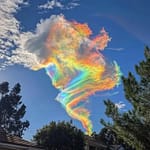An example of live weather Radar from I’m Weather, part of Meteox.
Weather radar is an invaluable tool in meteorology, providing critical data that helps us understand and predict weather patterns. Here are some key reasons why weather radar is so useful:
Real-Time Monitoring
Weather radar allows for real-time monitoring of weather conditions. This capability is crucial for tracking severe weather events such as thunderstorms, tornadoes, and hurricanes. By observing these phenomena as they develop, meteorologists can issue timely warnings to protect lives and property.
Precipitation Measurement
One of the primary functions of weather radar is to measure precipitation. It can detect the intensity, type (rain, snow, sleet, hail), and movement of precipitation. This information is essential for accurate weather forecasting and for understanding the distribution and amount of rainfall over a specific area.
Storm Tracking
Weather radar is instrumental in tracking the movement and development of storms. By analyzing radar data, meteorologists can predict the path and intensity of storms, allowing for better preparedness and response. This is particularly important for managing the impacts of severe weather on communities and infrastructure.
Improved Forecasting
The data collected by weather radar enhances the accuracy of weather forecasts. Radar provides detailed information about the atmosphere’s current state, which can be used to improve short-term and long-term weather predictions. This leads to more reliable forecasts, helping individuals and organizations make informed decisions.
Aviation Safety
Weather radar plays a critical role in aviation safety. It helps pilots and air traffic controllers monitor weather conditions along flight paths, ensuring that aircraft can avoid hazardous weather. This reduces the risk of weather-related accidents and improves overall flight safety.
Hydrology and Flood Management
In hydrology, weather radar is used to monitor and predict river flows and potential flooding. By providing accurate precipitation data, radar helps in managing water resources and mitigating the impacts of floods. This is vital for protecting communities and infrastructure from flood damage.
Climate Research
Weather radar data is also valuable for climate research. It provides long-term records of precipitation and storm patterns, which are essential for studying climate change and its effects on weather systems. This research helps scientists understand how our climate is evolving and informs strategies for adaptation and mitigation.
In summary, weather radar is a powerful tool that enhances our ability to monitor, predict, and respond to weather conditions. Its applications range from improving daily weather forecasts to ensuring aviation safety and managing natural disasters. By providing real-time, accurate data, weather radar plays a crucial role in protecting lives, property, and the environment.
What is Weather Radar?

Weather radar is a type of radar used to locate precipitation, calculate its motion, and estimate its type (rain, snow, hail, etc.). It works by sending out a pulse of radio waves and then listening for any echoes that bounce back from objects in the atmosphere, such as raindrops or snowflakes. Here’s a breakdown of how it works and why it’s important:
How Weather Radar Works
- Transmission: The radar system emits a pulse of radio waves into the atmosphere.
- Reflection: When these waves encounter precipitation particles, they are scattered in all directions. Some of these scattered waves are reflected back towards the radar.
- Reception: The radar system receives the reflected waves and measures the time it took for them to return. This helps determine the distance to the precipitation.
- Analysis: By analyzing the strength and frequency shift of the returned signal, the radar can estimate the intensity and type of precipitation, as well as its movement.
Importance of Weather Radar
- Real-Time Monitoring: Weather radar provides real-time data on precipitation, which is crucial for tracking severe weather events like thunderstorms, tornadoes, and hurricanes.
- Forecasting: The data collected by weather radar helps meteorologists make accurate short-term weather forecasts and issue timely warnings.
- Safety: Weather radar is essential for aviation safety, helping pilots avoid hazardous weather conditions.
- Flood Management: It aids in monitoring and predicting heavy rainfall and potential flooding, allowing for better preparedness and response.
- Research: Weather radar data is valuable for studying weather patterns and improving our understanding of atmospheric processes.
Weather radar is a powerful tool that enhances our ability to monitor and predict weather conditions, ultimately helping to protect lives and property.
Hi I am Marcus, MM0ZIF, a licenced Radio Amateur, Doctor of Musicology, amateur weather enthusiast. I over the years have been a Amateur Radio Tutor, Examiner, and a Regional Manager for the Radio Society of Great Britain.
This site is dedicated more towards Amateur Radio and Weather, with an angle on Technology too. I also maintain https://havenswell.com/ which is my other blog which is more aimed at cooking, hobbies and life in general as well as businness and networking.












